This is a very belated post, truly belated post.
Remember when I visited Luxor and Aswan in 2012 and how I shared photos from the trip especially in Aswan!?
I shared photos from Aswan’s High Dam, Temple of Philae, Kitchener’s Island, Temple of Kom Ombo and Temple of Edfu. I shared also photos from Luxor’s world-famous Karnak Temples complex.
I remembered that I have not shared or uploaded the photos of other landmarks in Luxor: Luxor Temple and Hatshepsut Temple. I visited the Valley of the Kings too, but I followed the instructions then that said explicitly “No photography”. Now, people take photos and film videos easily thanks to mobile phones.
Yes, I forgot to post them all those years and I do not have any good excuse, to be honest
Anyhow, I guess now it is the perfect time to share those photos especially it seems that we are on the verge of another possible wave of coronavirus lockdown in the world and we may have to stay at home once again till the vaccines are distributed fairly and freely hopefully.
Kodak Agfa will go back in time to February 2012 and visit the great and marvellous Luxor Temple in two-parts posts.
There is a little reminder here: The photos are not that great as Kodak Agfa was still finding her way with photography using baby Sony Nex 5.
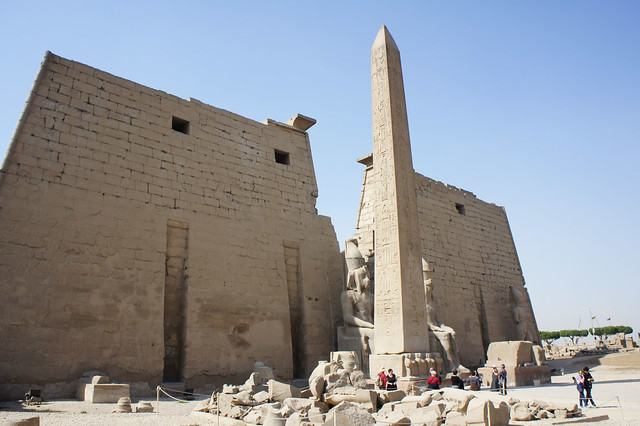 |
| The Temple of Luxor's great pylon with its famous obelisk |
I do not know where I shall start the story of Luxor Temple. It is uneasy to recount the history of one of Egypt’s oldest temples that still standing after 3,000 years of its construction and inauguration. The history of that temple complex is like a layer over layer.
Most of the Temple Complex of Luxor was constructed during the New Kingdom but it may go further than this.
Some say that its area which is close to the bank of the Nile was considered scared and was dedicated to the cult of Amun since the 11th dynasty in the Middle Kingdom but the actual construction itself of the current temple complex was during the New Kingdom especially during the 18th and the 19th dynasties aka the Golden age of the New Kingdom.
The construction in the temple complex did not stop after those two dynasties, on the contrary, it continued playing a role in the city of Luxor and Egypt itself till the Greco-Roman era and even beyond as you will see.
 |
| The avenue of Sphinx outside Luxor temple |
Here is my best attempt starting with the first photo I took for this majestic place from our bus.
There we were in front of the iconic entrance of the temple and in front of it the famous Sphinxes avenue.
The sphinx avenue used to connect between the Luxor temple complex and Karnak temple complex.
According to historical accounts, that current surviving sphinxes avenue was built by King Nectanebo I, the founder of Egypt’s last native ruling dynasty aka 30th dynasty in the late period.
 |
| The avenue of Sphinx at Luxor Temple |
It is said that the face of the sphinxes depicted Nectanebo I in accordance with the famous ancient Egyptian tradition that started in the old kingdom. Nectanebo I also built a courtyard outside the temple’s first gate aka pylon.
For years, the Egyptian government has been working to revive this avenue between Karnak and Luxor temples since 2009 and in process, it evacuated and demolished houses that were built illegally.
The evacuation process did not go that smoothly. Last year it caused a little clash between the security forces and some of the locals. According to other locals from Qena whom I spoke with during then, part of those who live in that area worked in the illegal excavation of antiquities.
The evacuation and demolishment are still going on and reviving the old procession avenue between the two ancient temples made the government demolish a mosque and a church.
Just as you finish the avenue of sphinxes and on your way to the Luxor temple famous’ pylon, on your right hand you will see a little ancient building which is the chapel of Serapis.
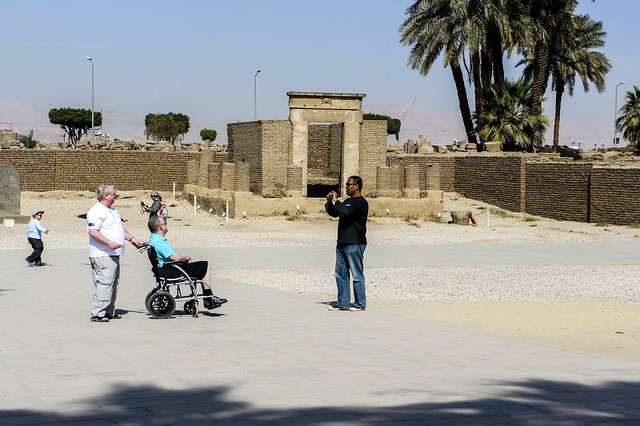 |
| Two tourists in front of the Serapis Chapel |
That small mudbrick shrine was built in the early second century “year 126” dedicated to the ancient Egyptian deity Isis and Egyptian-Greco deity Serapis who replaced Osiris in the country by then.
 |
| The Serapis chapel |
That shrine was presented as a gift to Roman Emperor Hadrian on his birthday.
According to some archaeologists Luxor temple was not for ISIS or Serapis or Osiris, this temple was originally dedicated to the Theban triad then aka deities Amun, Mut and Khensu.
Yet by time this temple complex was not about worshipping ancient deities but rather a place dedicated to the cult of the Royal Ka aka the divine Egyptian ruler aka this was the official and original birthplace of the President cult.
Some Kings were crowned in that temple complex to be the ultimate pharaohs of Egypt with the blessing with the Theban triad.
That is why kings made sure to either build new parts or rebuild old part in it and that’s why it continued to expand beyond the Modern Kingdom.
Interestingly, Alexander the Great claimed to be crowned as the King of Egypt there but some historians dispute that claim saying that the Macedonian legendary king and war master did not go beyond Memphis aka Giza now.
This shows you the importance and significance of that old complex to Egypt.
The complex’s pylon area is the greatest example given on the Royal Ka or presidential cult.
Luxor Temple Complex Pylon aka Ramses II Pylon
 |
| The remaining Luxor temple obelisk |
Before entering the court of the magnificent temple, you will meet the famous obelisk of Luxor Temple.
This is a 3,000-yellow granite obelisk inscribed with hieroglyphs in honour of King Ramesses II of the famous 18th dynasty.
Legend says that Ramses II was the man that created the infamous Presidential cult in Egypt and the world.
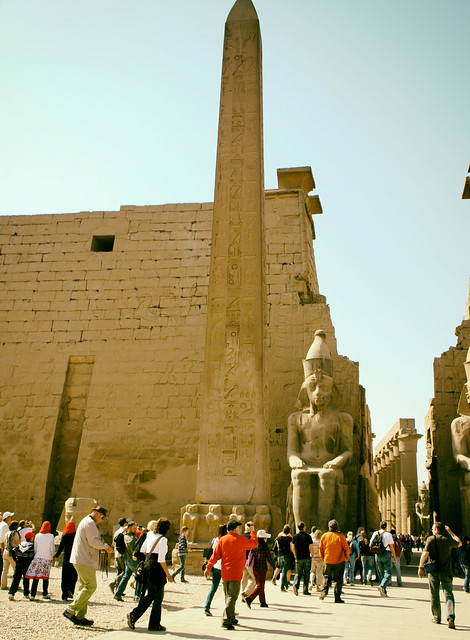 |
| The remaining Luxor temple obelisk |
There were two obelisks originally in the entrance of the temple made by for King Ramses II but in 1833 Mohamed Ali Pasha decided to give up one of the two obelisks to France in exchange of a French mechanical clock.
The founder of Modern Egypt who did not see or realize a problem in giving up Egypt’s monuments gave up the right obelisk to France and currently it is at the centre of the Place de la Concorde in Paris, France.
Ironically, the French mechanical clock has not worked till our day. It is currently at the Citadel in Cairo.
 |
| The base of the Paris Oblesik is still there |
The remains of the broken bases of the right obelisk are still there.
At the base of the obelisks, there are 4 baboons representing ancient Egyptian virility of the dead Babi and because its name meant in ancient Egyptian “Bull of the baboons”, it was usually depicted a baboon with an erection.
 |
| The baboons or Babis at the base of the obelisk |
The 19th century France thought the baboons on the base of the obelisk it got from Mohamed Ali Pasha was a bit “sexed-up” and “erotic” for the public and thus the granite statues of the four baboons were shipped to the Egyptian section to the Louvre.
The Louvre Baboons are in a better shape their brothers in Luxor because they are kept away the erosion factors judging from the photos but still, they should have not been removed.
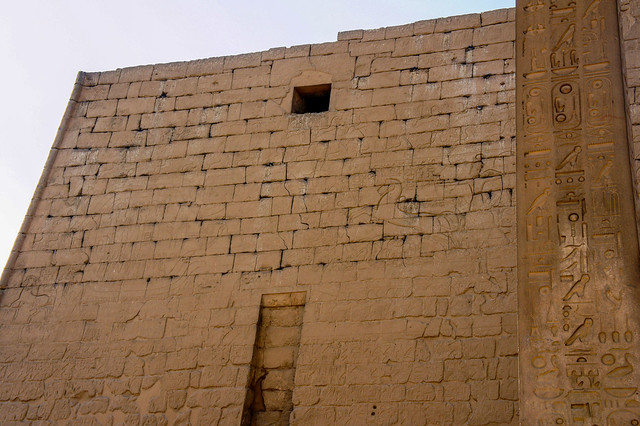 |
| Ramses II in his war cart in one of his battles on the temple's pylon |
Then come the outer walls of the pylon, you can find the depictions immortalizing the military victories of Ramses II on his chariot in the Levant.
Those drawings or inscriptions showing the famous king on his war cart conquering his enemies were once coloured but unlike the colours in the ancient Egyptian tombs or other ancient Egyptian temples, the colours could not survive time.
 |
| Ramses II in his war cart in one of his battles on the temple's pylon |
Right beside the remaining obelisk, there were remains of broken statues of Ramses II too.
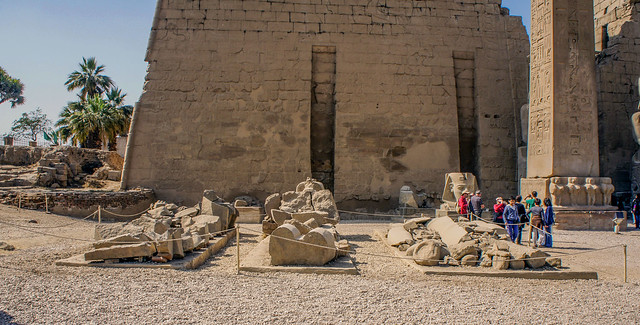 |
| The destroyed statues then |
Those statues were broken due to an earthquake from what I read.
Those remains were put together into newly restored Ramses II statues erected in 2019.
It was not without controversy. There had been a debate about their correct location in the temple complex.
 |
| Ramses II with his subjects after 3000 years |
Let’s agree that he made sure that his name would be remembered nearly three millenniums after his death.
I mean his two colossal statues before at the pylon’s gate are like one of the unique trademarks of the temple.
 |
| The colossal statues of Ramses II at the pylon |
There are more Ramses II statues inside as you can see.
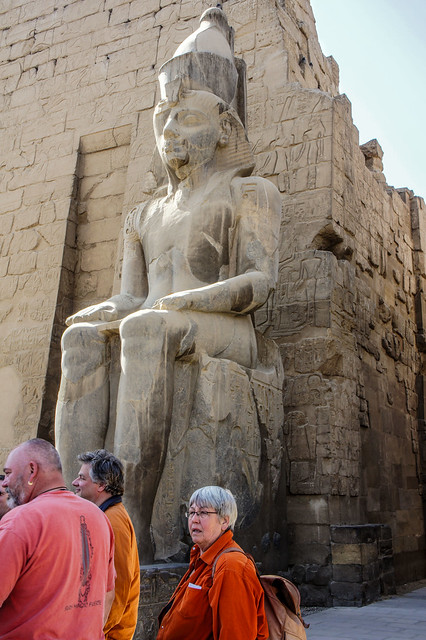 |
| The colossal statue of Ramses II at the pylon |
They are just colossal for real and time was not that merciful to them.
The base of the colossal statues depicting Ramses II sitting show his foreign captives from men and he captured in his military conquests.
 |
| The foreign captives of Ramses II's battles |
You can see that they are foreigners from their facial features and their hairstyle.
Then you go inside to the first courtyard inside the temple complex and it was also built by none other Ramses II with more of his statues.
 |
| The first courtyard, originally built by Ramses II |
But on your left hand as you enter or if you look around, you will find another surprising building inside the courtyard.
 |
| The building on the top of another building |
You can not miss the fact that it is newer than the rest of the temple.
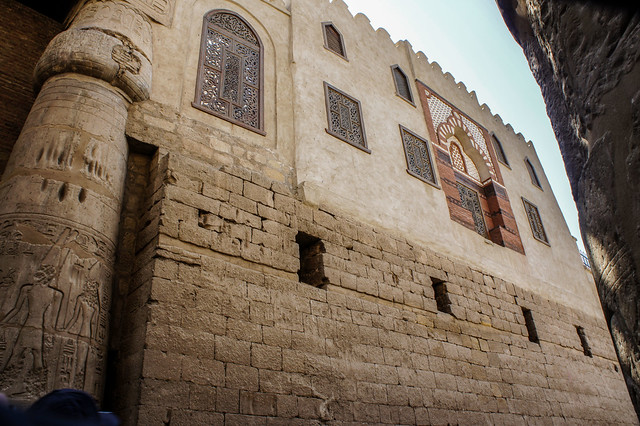 |
| The Mosque and Shrine of Sufi Sheikh Abu Haggag |
This building is actually a small mosque and shrine of Sufi Sheikh called Abu Haggag.
I did not enter it but according to those who prayed there, the ancient Egyptian inscriptions on the columns can be seen till that day. It is an amazing experience according to those who tried it and prayed there.
Yearly, the Sufi orders of upper Egypt hold a moulid to celebrate Sufi Sheikh Abu El-Haggag outside the temple complex. It is one of Egypt’s big Sufi moulids
 |
| The Mosque and Shrine of Sufi Sheikh Abu Haggag inside Ramses II courtyard |
For me, the small shrine and mosque of Sheikh Abu Haggag is the living example on the multi-layers of that temple complex which realistically speaking presents a religious service partially till this day.
During the Roman era, that part of the temple was converted into a Church in 395 AD. Later in 640 AD, it was converted as a mosque and a shrine for a Sufi Sheikh who reportedly was born in Baghdad.
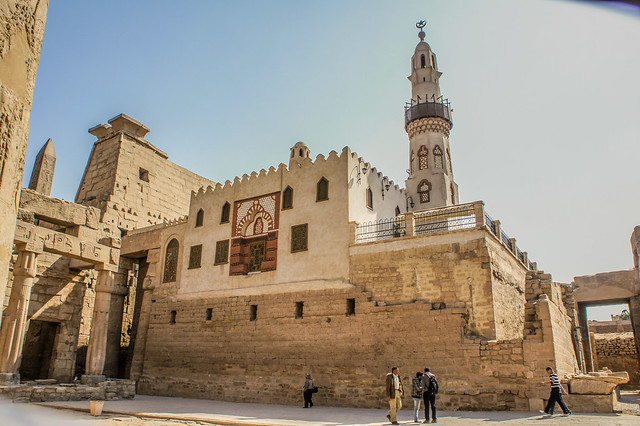 |
| The Mosque and Shrine of Sufi Sheikh Abu Haggag |
Sheikh Youssef Ibn Abdel Rahim is said to be a descend of Al-Hussein Ibn Ali, which means he is one of the great descendants of Prophet Mohamed “PBUH” and he is buried in Ramses II Sun courtyard.
One important remark the Church and then the Mosque were not built directly on the courtyard for decades layers and layers of land covered the original ancient Egyptian temple complex beneath it.
 |
| The original courtyard design |
To give you an idea, on how the courtyard should have looked without the small church and the mosque, you can look into the opposite side.
People began to live on the top of the temple after it was hidden underneath an artificial hill “14.5 to 15 metres”.
Personally, I believe the Nile Flood played a role in that.
There was nearly a small village over the temple.
The old village photos are mind-boggling and honestly, I want to publish all those photos from the past showing how that temple complex was buried under a whole village.
 |
| That photo was reportedly taken in the 19th century you can see the mosque and artificial hill "Dr Ziad Morsy" |
In 1885, Egyptologist Gaston Maspero began to excavate in the area officially and professionally. The excavation or restoring the original temple continued from 1885 till 1960 officially.
It is even mind-boggling to imagine how this structure survived three millenniums like that !!
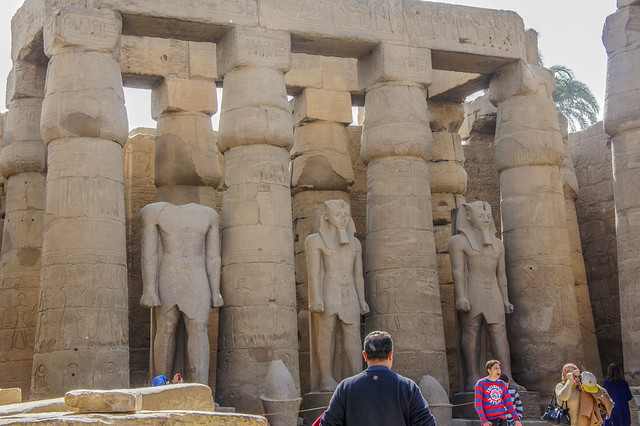 |
| Ramses II statues in the first courtyard |
I want to have a special before and after post inshallah for that temple.
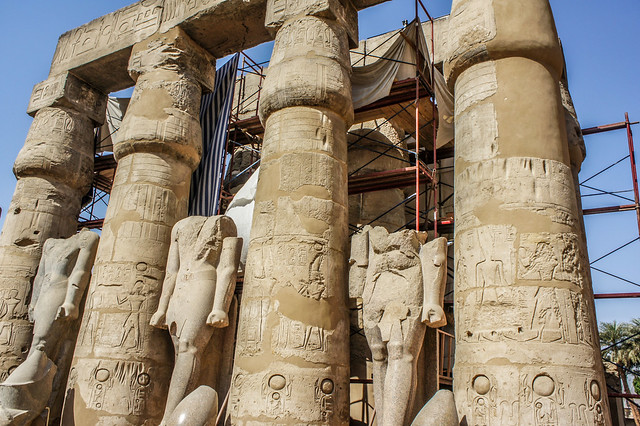 |
| Restoration works during then in 2012 |
Of course, there were lots and lots of restoration works in the temple complex.
 |
| The first courtyard |
It won’t be a Ramses II courtyard or the first Sun courtyard in that temple without lots and lots of statues dedicated to the king himself.
 |
| The first courtyard |
I mean I just can’t imagine the number of statues that man had when he used to rule his Empire !!
 |
| The first courtyard with lots Ramses II statues with and without heads |
I will stop here and will continue in another post inshallah :) I hope I was not boring and wait for the second part of this post inshallah.

Thoroughly enjoyed the beautiful photos of Luxor Temple both in out and sideways.
ReplyDeleteThanks :)
Delete